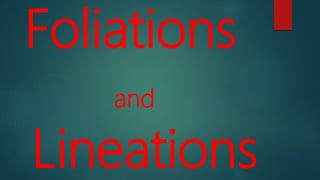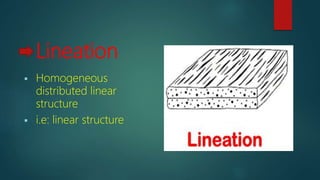Foliation and lineation
- 3. Presented To: Mr. Abdul Hannan (lecturer) Presented By: Amir Hamza BGLF13M034 Danish Qamar BGLF14M044 Dpt. Earth Sciences. University of Sargodha, punjab, Pakistan
- 4. A general understand of foliations and lineations, before the complete brief on foliations and lineations sepreately……
- 5. Foliation “ word foliation derived from latin word folium which means leaf” Homogeneous distributed planner structure in the roks i.e: planner feature
- 6. Lineation Homogeneous distributed linear structure i.e: linear structure
- 7. Primary Foliation and Lineation Foliations and lineations are primary if they were origenated by primary sedimentary and igneous process i.e: for sedimentary rocks,foliation and lineation forms during deposition and transportation before compaction. And for igneous rocks foliation and lineation forms during the crystallization of magma in preferred orientation.
- 8. Secondary Foliation and Lineation Foliations and lineations are secondary if they were originate by secondary process. Such as during tectonic activity/ deformation or during the Metamorphism.
- 9. Tectonics L-tectonics Linear preferred orientation. S-tectonics Planner preffered orientation.
- 10. Significance of foliations and lineations If foliations and lineations can be distinguished from one another by type, by cross-cutting relationships, absolute age and by microsope, Then we can help to study of tectonic and metamorphic evolution of area.
- 11. Now, we well dicussed Fliation and Lineation in further details as well as the types of each…..
- 14. Types of Foliations 1.Spaced Foliations a) compostional b) disjunctive c) crenulation 2.Contineous Foliations a) fine b) coarse
- 17. Compostional Foliations Compostional foliations are marked by the layers or lamina of different mineralogical compostion. A planer alignment of platey or niddle like crystals may be present. Compostional foliations are subdivided into…
- 18. Compostional Foliations a. Diffused Characterised by, Widely spaced Weak concentrations of minerals predomently of single lithology Common in Ulta-Mafic rocks b. Banded Characterised by, Relatively closed spaced Compostional layers Minerologically distinct and of compare-able abundance Common in high grade metamorphic gneisses.
- 19. Disjunctive Foliations Disjunctive word derived from Disjunctus a Latin word which means disjoined. A foliation that is formed in sedimentary rocks that have been subjected to tectonic differential stress under sub-greenschist metamorphic conditions. It is defined by array of subparallel fabric elements called cleavage domains, in which the original rock fabric and compostion have beeb markedly changed by the process of pressure solution. The domains are separated from one another by intervels, called microlithons in which the original rock is preserved.
- 21. On the basis of smoothness or regularity of cleavage domains we further divided disjunctive foliations into four groups. A. Stylolitic B. Anastomosing C. Rough D. Smooth
- 22. Stylolitic disjunctive foliations Cleavage domains are long, continuous but very irregular This type of foliations is typically in limestone in which cleavage domains are characteristically are thin, dark, clay seams.
- 23. Anastomosing disjunctive foliations Cleavage domains are long, continuous, wavey forming an irregular network outlining lenticular microlithons Such foliations are common in limestone and in phyllites and schists.
- 24. Rough disjunctive foliations Cleavage domains are short, discontinuous concentrations of highly oriented platey minerals. Typically abundant in rocks containing sand sized minerals.
- 25. Smooth disjunctive foliations Cleavage domains are long, continuous and smooth and have the concentrations of highly oriented platey minerals.
- 26. Crenulation Foliations Microlithons contains the microfolds of an earlier foliation. Crenulation foliations are formed by the harmonic wrinkles or chevron folds in preexisting foliation, the new foliation cut across the old foliation.
- 28. Contineous Foliations Contineous foliations are defined either by with a spacing less than 10micro-meter or by non-domainal structure. Fabric elements are homogeneously distributed. Consists of a non-layered homogeneous distribution of platy mineral grains with a preferred orientation.
- 29. Contineous Foliations Fine continuous- foliation e.g: Slate Coarse continuous- foliation e.g: Schist
- 32. Lineations 1.Structrual A. discrete B. constructed 2.Mineral A. polycrystalline B. mineral grain
- 34. Structrual Lineations Structrual lineations are defined by the preffered orientation of linear structure contained in rock. It includes the discrete and constructed lineations.
- 35. Structrual Lineations discrete Which are formed by the deformation of discrete objects such as ooids, pebbles, fossils etc. constructed Which are formed from planner features constructed or deformed during deformations and include the intersection of two foliations
- 36. Mineral Lineations Mineral lineations consist of preffered orientation of either individual elongate mineral grains or elongate polycrystalline aggregates. i.e mineral lineations includes the mineral grain and polycrystalline lineations.
- 38. Structrual Lineations Mineral grain Mineral grain lineations are formed by the parallel allignment of individual acicular (neddle like) mineral grains. polycrystalline Are formed by the preffered orientation of elongate clusters of grains of a particular mineral.
- 39. Rods are polycrystalline mineral lineations formed by the rod-shaped concentrations of a particular mineral commonly Qtz.
- 40. Foliations and lineations in rocks referenced to pakistan As we know that foliations and lineations majorly found in Metamorphic rocks. We shell have to travel up north, beyond Islamabad to see the metamorphic rocks. However Kirana hills near Sargodha also contains metamorphic rocks. You may also find some in northern Balochistan province e.g in Raskoh range. Around the Nagarparkar high you may find metamorphic rocks at its contect with the surrounding sedimentary rocks.









































